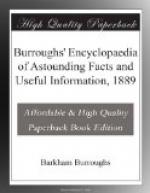Example. Find the cost of 50 yards of gingham at 14c a yard.
2)1400 ----- $7.00
When the price is one dollar and twenty-five cents, fifty cents, or any number found in the table, the result may be quickly found by finding the price for the extra cents, as in the above examples, and then adding this to the number of pounds or yards and calling the result dollars.
Example. Find the cost of 20 bushels potatoes at $1.12-1/2 per bushel.
8)2000
250
-----
$22.50
If the price is $2 or $3 instead of $1, then the number of bushels must first be multiplied by 2 or 3, as the case may be.
Example. Find the cost of 6 hats at $4.33-1/3 apiece.
3)600
4
------
24.00
2.00
------
$26
When 125 or 250 are multipliers add three ciphers and divide by 8 and 4 respectively.
To multiply a number consisting of two figures by 11, write the sum of the two figures between them.
Example. Multiply 53 by 11. Ans. 583.
If the sum of the two numbers exceeds 10 then the units only must be placed between and the tens figure carried and added to the next figure to the left.
Example. Multiply 87 by 11. Ans. 957.
FRACTIONS.
Fractional parts of a cent should never be despised. They often make fortunes, and the counting of all the fractions may constitute the difference between the rich and the poor man. The business man readily understands the value of the fractional part of a bushel, yard, pound, or cent, and calculates them very sharply, for in them lies perhaps his entire profit.
TO REDUCE A FRACTION TO ITS SIMPLEST FORM.
Divide both the numerator and denominator by any number that will leave no remainder and repeat the operation until no number will divide them both.
Example. The simplest form of 36/45 is found by dividing by 9 = 4/5.
To reduce a whole number and a fraction, as 4-1/2, to fractional form, multiply the whole number by the denominator, add the numerator and write the result over the denominator. Thus, 4 X 2 = 8 + = 9 placed over 2 is 9/2.
TO ADD FRACTIONS.
Reduce the fractions to like denominators, add their numerators and write the denominator under the result.
Example. Add 2/3 to 3/4.
2/3 = 8/12, 3/4 = 9/12, 8/12 + 9/12 = 17/12 = 1-5/12. Ans.
TO SUBTRACT FRACTIONS.
Reduce the fractions to like denominators, subtract the numerators and write the denominators under the result.
Example. Find the difference between 4/5 and 3/4.
4/5 = 16/20, 3/4 = 15/20, 16/20-15/20 = 1/20. Ans.
TO MULTIPLY FRACTIONS.
Multiply the numerators together for a new numerator and the denominators together for a new denominator.




